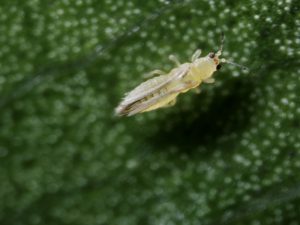It’s that time of year again – blueberry season! I know I’m excited! Blueberries are a major crop grown here in Florida with ~7,000 acres of commercial blueberries. In addition, there are many U-Pick operations scattered throughout this region. Who wouldn’t want ‘Fresh from Florida’ blueberries? Spring is a great time to go out and pick buckets of blueberries, but Spring is also a perfect time for pests to affect blueberry crops. One pest that has become a potential problem is the Chilli Thrip.
What are Chilli Thrips?

Chilli Thrips are an invasive pest and were first observed in Florida around 1991. The first established population was reported in 2005, specifically on roses in Palm Beach County, and 2008 was the first recorded population in blueberry. Chilli Thrips have a short life cycle that lasts ~18-20 days and go through four life stages: egg, larvae, pupa, and adult. A female can lay around 60 kidney-shaped eggs in its lifetime and deposit eggs into soft plant tissue. Eggs will usually hatch in 5-8 days and larvae will begin feeding, going through two instars. Thrips will then go through pupation.
Identification:
Chilli Thrips are becoming more of an issue in blueberry production. They are smaller than flower thrips, approximately 0.04 inches long and can be seen with a hand lens. Adults have pale yellow bodies with dark fringed wings and dark spots across the back of the abdomen. They have wide heads with antennae. Thrips are not strong fliers and disperse over short distances using their fringed wings. This initially causes ‘hot spots’ in blueberry fields till thrips move to adjacent plants within the field.
Crop Damage:

Chilli Thrips feed on new vegetative blueberry growth in late spring to summer after bush pruning. Thrips cause damage on young leaves, such as leaf bronzing along leaf veins and petioles, leaf curl, and shoot dieback. Heavy infestations occur during prolonged hot and dry periods, causing extensive leaf curling and leaf defoliation. Early detection of Chilli Thrips is essential for effective control, so a good indication of thrips can be the appearance of bronzing on new flush. Distribution of thrips is irregular within a field.
Cultural Controls:
- Utilize an integrated pest management plan
- Eliminate host plants in or near blueberry crop, such as weeds
- Introduce natural enemies – minute pirate bug, predatory mites, big-eyed bugs
Chemical Controls:
Reduced-risk insecticides registered for use in blueberries are spinetoram, tolfenpyrad, cyantraniliprole, novaluron, acetamiprid, and flupyradifurone. For organic production, one can use spinosad. Check out the UF Chilli Thrips on Blueberries in Florida askIFAS Website for proper management practices. THE LABEL IS THE LAW. If you have concerns of Chilli Thrips in your crop, feel free to call me at the UF/IFAS Suwannee County Extension Office, an Equal Opportunity Institution, for control recommendations at 386-362-2771.
 0
0
